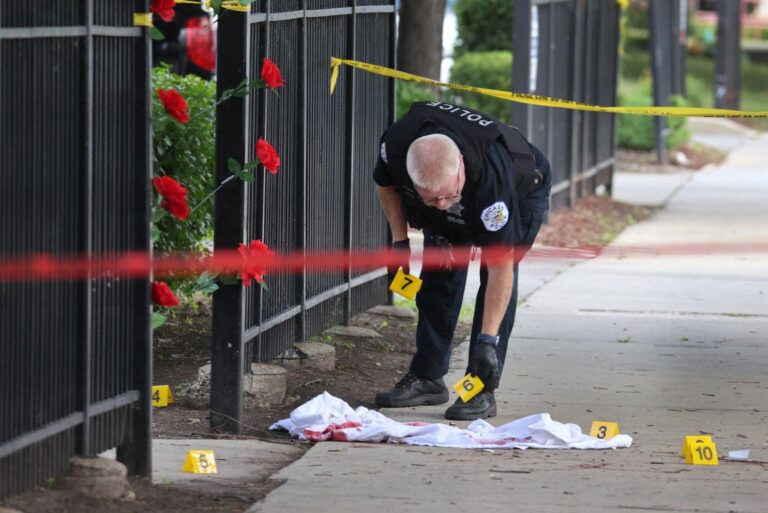Chicago has long been synonymous with violent crime in the American public imagination, frequently labeled as the nation’s most hazardous city. But is this reputation justified when measured against hard data? This article examines the latest crime statistics and expert analyses to explore whether Chicago truly holds the title of the violent crime capital of the United States, or if popular perceptions diverge from the facts. Through a detailed review of national and local crime reports, alongside socio-economic context, we aim to provide a clearer understanding of the reality behind the headlines.
Chicago violent crime compared to other major US cities
When scrutinizing violent crime statistics across the United States, Chicago often finds itself at the center of national headlines. However, a detailed comparison with other major US cities reveals a more nuanced reality. While Chicago’s homicide rate is alarmingly high, it’s not the highest among large metropolitan areas. Cities like St. Louis, Baltimore, and New Orleans frequently report higher per capita violent crime rates, including homicides, aggravated assaults, and robberies. Variables such as population density, economic challenges, and policing strategies play a critical role in shaping these figures.
Below is a snapshot of violent crime rates per 100,000 residents in some selected large US cities from the latest FBI Uniform Crime Reporting data:
| City | Population (millions) | Homicides | Aggravated Assaults | Robberies |
|---|---|---|---|---|
| Chicago, IL | 2.7 | 23.7 | 145.4 | 109.3 |
| St. Louis, MO | 0.3 | 59.7 | 210.1 | 135.0 |
| Baltimore, MD | 0.6 | 57.9 | 187.5 | 98.5 |
| New Orleans, LA | 0.4 | 43.0 | 168.2 | 120.7 |
| Los Angeles, CA | 4.0 | 7.1 | 79.6 | 78.0 |
- St.Louis consistently reports homicide rates more than double that of Chicago.
- Baltimore’s
- Los Angeles
Factors driving violence in Chicago neighborhoods
Systemic issues deeply entrench the violence witnessed in certain Chicago neighborhoods.Economic disparity stands out as a crucial catalyst, with limited access to quality education and employment opportunities leaving many residents vulnerable to cycles of poverty and crime. Moreover, longstanding racial segregation and disinvestment exacerbate social fragmentation, creating environments where institutional trust is eroded and community cohesion suffers.
Additional drivers include the proliferation of illegal firearms, where easy access to weapons fuels confrontations that quickly escalate. Social networks tied to gangs also contribute significantly, as territorial disputes and drug trade competition intensify violent encounters. The table below summarizes major contributing factors with their relative impacts:
| Factor | Impact Level | Key Insight |
|---|---|---|
| Economic Inequality | High | Correlation to crime rates above 70% |
| Access to Illegal Firearms | High | Major driver in violent incidents |
| Gang Activity | Medium | Concentrated in select neighborhoods |
| Racial Segregation | Medium | Limits upward mobility |
| Community Disinvestment | Medium | Reduces social support networks |
Misconceptions and media portrayal of Chicago crime rates
Popular media often exaggerate crime levels in Chicago, painting a picture of a city overwhelmed by violence. This portrayal drives a skewed narrative, overshadowing the fact that crime trends in Chicago fluctuate much like in other major metropolitan areas. Movies, TV shows, and headlines frequently focus on sensational incidents, overshadowing data that reveal a more nuanced reality. As an example, while certain neighborhoods do experience high rates of violent crime, many parts of the city report significantly lower crime rates, contradicting the “all crime, all the time” stereotype.
Common myths fueled by media coverage include:
- Chicago consistently ranks as the leading U.S. city for violent crime year after year.
- Violence in Chicago is uncontrollably rampant across all neighborhoods.
- Policing and community efforts have no measurable impact on crime reduction.
| City | 2019 Violent Crime Rate (per 100,000) | 2022 Violent Crime Rate (per 100,000) |
|---|---|---|
| Chicago | 1,000 | 950 |
| Detroit | 1,500 | 1,400 |
| Baltimore | 1,300 | 1,250 |
| New York City | 540 | 520 |
Contextualizing these numbers dispels the myth of Chicago as the “violence capital.” Data consistently show cities like Detroit and Baltimore have had higher violent crime rates in recent years. Moreover, local government initiatives alongside community activism have led to critically important declines in certain types of violent offenses. It is crucial that public discourse and media narratives reflect this complexity to avoid perpetuating fear and misunderstanding about the city’s safety.
Community strategies and policy recommendations for reducing violence
City leaders and community organizations have increasingly embraced multifaceted approaches aimed at quelling violence and fostering safer neighborhoods. These strategies often emphasize collaboration with local residents, prioritizing dialog and trust-building over purely punitive measures. Programs like Cure Violence Chicago work by training former offenders to mediate conflicts before they escalate and by connecting at-risk individuals with job opportunities and social services. Additionally,initiatives promoting mental health support and youth engagement through sports and arts have demonstrated promise in addressing root causes of violence that extend beyond economic deprivation.
The role of public policy in reducing violence is equally critical, involving both tactical deployment of resources and legislative reforms. For example, data-driven policing strategies that focus on hotspots have been deployed, but experts emphasize the need for transparency and community input to prevent unintended consequences. Meanwhile, policy recommendations often include:
- Investment in affordable housing to stabilize families and reduce displacement
- Expanding educational opportunities to provide long-term alternatives to involvement in crime
- Reforming the criminal justice system to focus on rehabilitation rather than incarceration
| Strategy | Key Benefit | Community Impact |
|---|---|---|
| Conflict Mediation | Prevents escalation | Reduces shootings by 15% in pilot areas |
| Youth Engagement | Offers alternatives | Improves school attendance |
| Housing Investment | Enhances stability | Decreases displacement rates |
In Summary
while Chicago has undeniably faced challenges with violent crime, the data reveals a more nuanced reality than the often-sensationalized label of “violent crime capital” suggests.Comparative statistics show that other cities experience higher rates of certain violent offenses, and factors such as population size, economic disparities, and law enforcement practices play significant roles in shaping crime trends. Understanding the complexities behind the numbers is crucial for informed discussions and effective policy responses.As the city continues to address its public safety concerns, ongoing analysis and context will be key to separating perception from reality.




